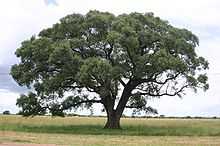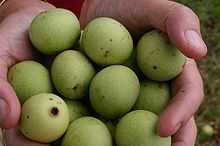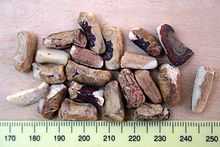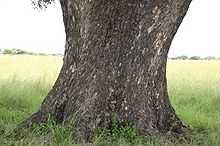Sclerocarya birrea
| Sclerocarya birrea | |
|---|---|
 | |
| Scientific classification | |
| Kingdom: | Plantae |
| (unranked): | Angiosperms |
| (unranked): | Eudicots |
| (unranked): | Rosids |
| Order: | Sapindales |
| Family: | Anacardiaceae |
| Genus: | Sclerocarya |
| Species: | S. birrea |
| Binomial name | |
| Sclerocarya birrea (A. Rich.) Hochst. | |
| Synonyms | |
|
Poupartia birrea (A. Rich.) Aubrév | |



Sclerocarya birrea, the marula, (Greek σκληρός, sklērós, "hard", and κάρυον, káryon, "nut", in reference to the stone inside the fleshy fruit) is a medium-sized dioecious tree, indigenous to the miombo woodlands of Southern Africa, the Sudano-Sahelian range of West Africa, and Madagascar. The tree is a single stemmed tree with a wide spreading crown. It is characterised by a grey mottled bark. The tree grows up to 18 m tall mostly in low altitudes and open woodlands. The fruits are used in the liqueur Amarula. The distribution of this species throughout Africa and Madagascar has followed the Bantu in their migrations, as it has been an important item in their diet since time immemorial.
The fruits which ripen between December and March have a light yellow skin, with white flesh, rich in vitamin C—about eight times the amount found in an orange—are succulent, tart with a strong and distinctive flavour.[2] Inside is a walnut-sized, thick-walled stone. These stones, when dry, expose the seeds by shedding 2 (sometimes 3) small circular plugs at one end. The seeds have a delicate nutty flavour and are much sought after, especially by small rodents who know to gnaw exactly where the plugs are located.
Relationships: Belongs to the same family Anacardiaceae as the mango, cashew, pistachio and sumac, and is closely related to the genus Poupartia from Madagascar.
Common names:
- Tshivenda:mafula
- English: jelly plum, cat thorn, morula, cider tree, marula, maroola nut/plum
- Afrikaans: Maroela[3]
- Bambara: nkuna, nkuntan
- Portuguese (Mozambique): canhoeiro
- Hausa: dania
- Sotho: Morula[3]
- Swahili: mng'ongo
- Shona: mutsomo, mukwakwa, mushomo, muganu, mupfura; [fruits] pfura; [tree] mufura, mafuna, marula
- Tswana: Morula[3]
- Northern/Southern Ndebele: iganu, ikanyi, umganu, umkano
- Swazi: [fruits] emaganu, [tree] umganu
- Zulu: Umganu,[3] [fruits] amaganu, [seeds, tree] umganu
- Other: Boran (Kenya) – didissa ; Kamba (Kenya) – muua; Kwangali – ufuongo; Lovedu – marula; Maasai (Kenya) – ol-mangwai; Meru (Kenya) – mura; Pedi [fruits] – lerula, marula; Pedi [tree] – morula, merula; Pokot (Kenya) – oruluo; Ronga (Mozambique) – ncanhi; Sebei (Kenya) – katetalum; Shangaan – nkanyi, inkanyi; Diga (Kenya) – mngongo; Tonga: tsua, tsula, umganu; Tugen (Kenya) – tololokwo; Dinka (Sudan) – Gummel; Nuer (Sudan) – Kamel, Omel; Moru (Sudan) – Kyele; Luo (Kenya) Ong'ono.
The Marula tree is protected in South Africa.[3]
Traditional Uses
While little known globally, the fruit is traditionally used for food in Africa, and has considerable socioeconomic importance.[4]
The seed kernels are high in protein and fat, with a subtle nutty flavour, and constitute an important emergency food. Marula oil, made from the seed kernel, is a delicious additive to meals in Africa. It contains antioxidants and oleic acid. The bark is used both as treatment and a prophylaxis for malaria. An infusion of the inner bark of the marula tree may be applied to scorpion stings and snake bites to alleviate pain. The leaves are chewed on to help indigestion and to treat heartburn. Marula oil, made from the seed kernel, can be used as a type of skin care oil. Products of fruits and the tree are useful in crafts and agriculture. Gums exudates from the stem are mixed with water and soot to make ink by certain tribes in the region. The bark also yields a red-brown dye used in colouring traditional craft ware. The fruit infusion is used to bathe tick-infested livestock. The fruit is regarded as a potent insecticide.[citation needed]
Commercial Uses
On an industrial level the fruit of the marula tree is collected from the wild by members of rural communities on whose land the trees grow. This harvest and sale of fruit only occurs during two to three months but is an important income to poor rural people. The fruit is delivered to processing plants where fruit pulp, pips, kernels and kernel oil are extracted and stored for processing throughout the year.
The most important industrial product is Amarula which is probably still the second largest selling cream liquor in the world. Mirma, based in Phalaborwa, assembles and processes 4,000 tons a year of fruit. They produce a pulp from the skin and flesh which is refrigerated and shipped to Distel in the Cape Winelands. Here it is fermented, distilled, matured, blended and bottled before being internationally distributed.
Another fruit based product is a frozen marula puree, which is produced by Bronpro in Nelspruit. Bronpro supply puree to food manufacturers who use it as an ingredient in their products. The best known of these products is Marula Mania a juice blend produced by The Ceres Beverage Company under the Liquifruit label.
The third largest marula fruit based industry, is the production of marula oil as an ingredient for cosmetics. This tends to be scattered amongst many producers although PhytoTrade Africa is probably the leading "supplier" to the cosmetics industry through its integration of the production of many producers.
Popular culture
The alcoholic distilled beverage (maroela mampoer) made from the fruit is referenced in the stories of the South African writer Herman Charles Bosman.
The marula fruit is also eaten by various animals in Southern Africa. In the movie Animals Are Beautiful People by Jamie Uys, released in 1974, some scenes portray elephants, warthogs and monkeys becoming intoxicated from eating fermented marula fruit. Later research showed that these scenes, at least in large animals were improbable and, in all probability, staged. Elephants would need a huge amount of fermented marulas to have any effect on them, and other animals prefer the ripe fruit. The amount of water drunk by elephants each day would also dilute the effect of the fruit to such an extent that they would not be affected by it.[5]
Marula fruit is used to make Amarula liqueur.
See also
- List of Southern African indigenous trees
References
- ↑ "Entry for Sclerocarya birrea". JSTOR Global Plants. JSTOR. Retrieved 2014-01-12.
- ↑ Wickens, G. E.; Food and Agriculture Organization (1995). "Potential Edible Nuts". Edible Nuts. Non-Wood Forest Products 5. Rome: Food and Agriculture Organization. ISBN 92-5-103748-5. OCLC 34529770. Retrieved 2008-11-10.
- ↑ 3.0 3.1 3.2 3.3 3.4 "Protected Trees". Department of Water Affairs and Forestry, Republic of South Africa. 3 May 2013.
- ↑ National Research Council (2008-01-25). "Marula". Lost Crops of Africa: Volume III: Fruits. Lost Crops of Africa 3. Washington, D.C.: National Academies Press. ISBN 978-0-309-10596-5. OCLC 34344933. Retrieved 2008-07-17.
- ↑ Morris, Steve; David Humphreys and Dan Reynolds (2006). "Myth, marula, and elephant: an assessment of voluntary ethanol intoxication of the African elephant (Loxodonta africana) following feeding on the fruit of the marula tree (Sclerocarya birrea)". Physiological and Biochemical Zoology 79 (2): 363–9. doi:10.1086/499983. PMID 16555195. Retrieved 2012-07-30.
External links
http://www.swazisecrets.com/marulaafricanoils.asp